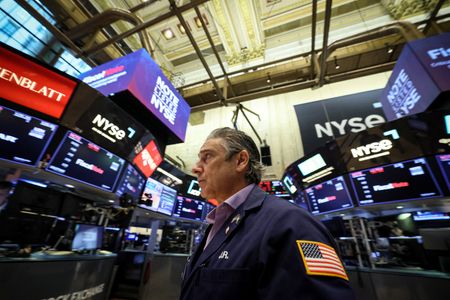By Stephen Culp
NEW YORK (Reuters) – Wall Street tanked in a broad sell-off on Thursday, as investor risk appetite was dashed by worries that the Federal Reserve’s restrictive monetary policy will remain in place for longer than anticipated.
All three major U.S. stock indexes tumbled more than 1% and benchmark 10-year U.S. Treasury yields touched a 16-year peak the day after Fed Chairman Jerome Powell warned inflation still has a long way to go before approaching the central bank’s 2% target.
Interest rate-sensitive megacaps, led by Amazon.com, Nvidia Corp, Apple Inc and Alphabet Inc dragged the S&P 500 and the Nasdaq to their lowest closing levels since June.
On Wednesday, at the conclusion of its two-day monetary policy meeting, the central bank left the Fed funds target rate unchanged at 5.25%-5.50%, as expected.
But revised economic projections, including the closely watched dot plot, showed interest rates will remain elevated through next year, dampening hopes for easing of policy before 2025.
“If you do have rates higher for longer, you have more strain on the system and more pressure on the economy,” said Thomas Martin, Senior Portfolio Manager at GLOBALT in Atlanta. “It gives people another chance to say that the lag time of higher rates – which we’re just starting to feel – might really bite.”
“We’re ratcheting up the possibility that we won’t get a soft landing,” Martin said, citing economic pressure from higher rates, along with student loan payments resuming, the UAW strike, a potential government shutdown, higher Treasury yields, climbing crude prices and a strengthening dollar.
An unexpected 9% drop in initial U.S. jobless claims, to the lowest level in eight months, played into the Fed’s notion that the labor market remains too tight, putting upward pressure on wages, and the economy is resilient enough to withstand higher rates for longer.
“Higher for longer” has become a common credo among the central banks of the world’s biggest economies as global policy tightening, in order to tame inflation, reaches its peak.
“The headlines this morning were quite something when it came to central banks,” Martin said. “All of them were hawkish.”
At 4:12PM ET, the Dow Jones Industrial Average fell 370.46 points, or 1.08%, to 34,070.42, the S&P 500 lost 72.2 points, or 1.64%, to 4,330 and the Nasdaq Composite dropped 245.14 points, or 1.82%, to 13,223.99.
All 11 major sectors of the S&P 500 lost nearly 1% or more, with real estate stocks suffering its biggest one-day percentage drop since March.
Semiconductor firm Broadcom slid 2.7% following a report that Alphabet-owned Google’s executives discussed dropping the company as a supplier of artificial intelligence chips as early as 2027.
The Philadelphia chip index shed 1.8%.
Klaviyo Inc gained 2.9% the day after its debut as a public company, while another recent IPO, Arm Holdings lost 1.4% to just a dollar above its $51 offer price.
Shares of FedEx jumped 4.5% after the package delivery company delivered a big profit beat.
Fox Corp and News Corp gained 3.2% and 1.3%, respectively, following news that Rupert Murdoch will step aside as chairman.
Declining issues outnumbered advancing ones on the NYSE by a 5.89-to-1 ratio; on Nasdaq, a 2.80-to-1 ratio favored decliners.
The S&P 500 posted three new 52-week highs and 29 new lows; the Nasdaq Composite recorded 22 new highs and 373 new lows.
Volume on U.S. exchanges was 10.76 billion shares, compared with the 10.12 billion average for the full session over the last 20 trading days.
(This story has been corrected to say 10-year Treasury yields touched 16-year peak, not 10-year peak, in paragraph 2)
(Reporting by Stephen Culp in New York; Additional reporting by Ankika Biswas and Shristi Achar A in Bengaluru; Editing by David Gregorio)





